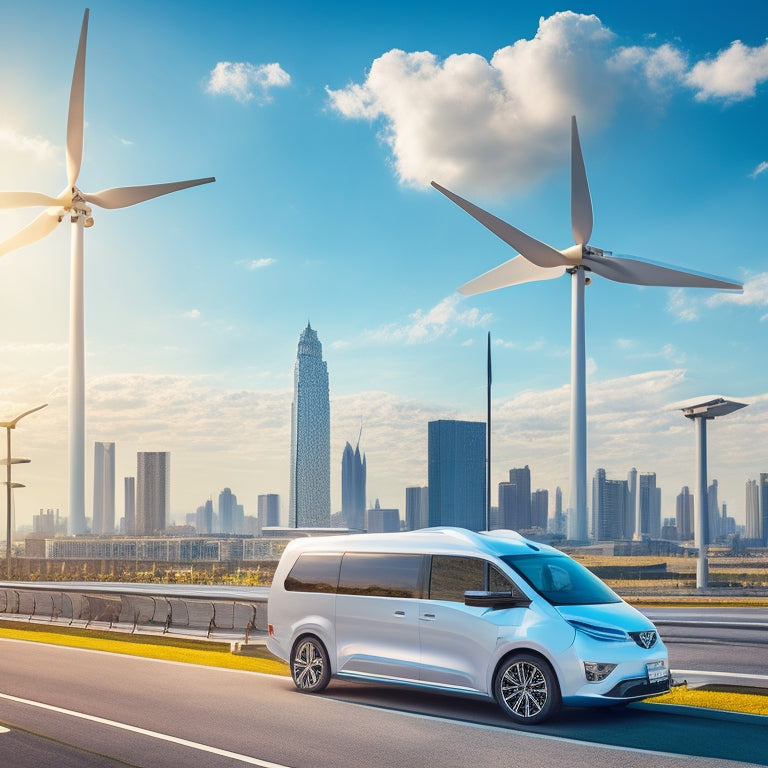
Why Fleet Vehicles Need Roof-Mounted Renewable Energy
Share
As you prepare to greenify your fleet, you'll want to recognize the importance of roof-mounted renewable energy systems. Fleet vehicles play a significant role in greenhouse gas emissions, air pollution, and climate change, making it essential to adopt sustainable solutions. By integrating roof-mounted renewable energy, you can reduce your carbon footprint, enhance energy independence, and even boost your bottom line. From cost savings to enhanced fleet performance, the benefits are undeniable. You're about to discover how roof-mounted renewable energy can revolutionize your fleet operations - and it starts with understanding the environmental impact of your fleet.
Key Takeaways
• Fleet vehicles can reduce greenhouse gas emissions and mitigate environmental harm by adopting roof-mounted renewable energy systems.
• Renewable energy adoption can lead to tangible impacts on reducing emissions and improving environmental sustainability.
• Roof-mounted renewable energy systems can ensure continuous fleet operation, minimize vulnerability to price fluctuations, and enhance energy security.
• Fleet operators can achieve significant cost savings through reduced fuel consumption, lower maintenance expenses, and optimized energy consumption.
• Integrating roof-mounted renewable energy systems can enhance fleet vehicle performance by improving fuel efficiency and power capacity.
Environmental Impact of Fleet Vehicles
As you operate your fleet vehicles, you contribute to the staggering 23% of greenhouse gas emissions attributed to the transportation sector. This significant contribution has devastating effects on the environment, particularly on air pollution and ecosystems.
The emissions from your fleet vehicles release harmful pollutants into the atmosphere, exacerbating air pollution and negatively impacting local ecosystems. The consequences are alarming, with air pollution causing respiratory problems and other health issues, while also damaging crops and forests.
The environmental impact of your fleet vehicles extends beyond air pollution, as they also contribute to climate change and ecosystem disruption. The burning of fossil fuels releases carbon dioxide, methane, and other greenhouse gases, accelerating global warming and altering ecosystems.
This, in turn, affects biodiversity, disrupts food chains, and threatens the delicate balance of ecosystems. It's crucial to acknowledge the environmental impact of your fleet vehicles and take proactive steps to mitigate their effects.
Reducing Carbon Footprint Matters
By adopting fleet vehicles with roof-mounted renewable energy, you can greatly lessen your carbon footprint, making a tangible impact on mitigating climate change.
As a fleet operator, you have a significant role to play in climate action. The transportation sector is one of the largest contributors to greenhouse gas emissions, and switching to renewable energy can markedly reduce your fleet's carbon footprint.
Increased Energy Independence Needed
You need to reduce your reliance on fossil fuels and increase energy independence by harnessing renewable energy sources, especially when it comes to powering your fleet vehicles. This is vital for achieving energy security, which is essential for guaranteeing the continuous operation of your fleet.
When you're not dependent on fossil fuels, you're less vulnerable to price fluctuations and supply chain disruptions.
Roof-mounted renewable energy systems can provide the energy independence you need. By generating power on-board, you can decrease your reliance on external energy sources, especially in rural areas where access to energy infrastructure may be limited.
This is particularly significant for fleets operating in remote areas, where energy security can be a major concern. With roof-mounted renewable energy, you can ensure a stable and reliable source of power, even in areas with limited rural access.
Cost Savings With Renewable Energy
As a fleet operator, you're likely always on the lookout for ways to reduce costs without compromising performance. By adopting roof-mounted renewable energy systems, you can experience significant cost savings, primarily due to reduced fuel consumption and lower maintenance expenses.
Frequently, fleet operators who adopt these systems see a substantial decrease in their energy expenditure.
To maximize these financial benefits, it's essential to conduct energy audits to identify areas of inefficiency in your fleet's energy usage. By pinpointing these areas, you can optimize your energy consumption and make data-driven decisions to reduce waste.
With roof-mounted renewable energy systems, you can harness free energy from the sun, reducing your reliance on fossil fuels and slashing your energy bills. The financial benefits are undeniable, and with the rising cost of fuel, it's more important than ever to explore alternative energy sources.
Enhanced Fleet Vehicle Performance
As you integrate roof-mounted renewable energy systems into your fleet vehicles, you can expect notable improvements in their overall performance.
You'll experience improved fuel efficiency, thanks to the supplemental power generated by the roof-mounted systems.
This, in turn, will increase your vehicles' power capacity while reducing emissions output, making your fleet more environmentally friendly and cost-effective.
Improved Fuel Efficiency
Installing roof-mounted renewable energy systems on fleet vehicles can greatly reduce fuel consumption, resulting in improved fleet vehicle performance and lower operating costs. As you consider integrating these systems into your fleet, you'll notice a significant impact on your vehicle's fuel efficiency. With reduced fuel consumption, you'll not only save on fuel costs but also reduce your carbon footprint.
To maximize the benefits of roof-mounted renewable energy, consider combining it with other fuel-saving strategies. For instance, aerodynamic modifications can further reduce wind resistance, allowing your vehicles to cut through the air with ease. Additionally, engine tuning can optimize your engine's performance, ensuring it runs efficiently and effectively.
Increased Power Capacity
You can boost your fleet vehicles' power capacity by integrating roof-mounted renewable energy systems. These systems enable them to haul heavier payloads and tow larger trailers. This increased power capacity is made possible by the high energy density of renewable energy systems, which can provide a significant power surge when needed.
With a roof-mounted system, you can tap into this energy reserve to tackle demanding tasks, such as transporting heavy loads or maneuvering steep inclines. The added power capacity also allows your fleet vehicles to accelerate more quickly, making them better suited for fast-paced delivery routes or emergency response situations.
Moreover, the instant torque provided by renewable energy systems enables your vehicles to maintain speed and momentum, even when carrying heavy payloads. By upgrading your fleet vehicles with roof-mounted renewable energy systems, you can access new levels of performance and productivity, while also reducing your carbon footprint.
Reduced Emissions Output
By incorporating roof-mounted renewable energy systems, your fleet vehicles can greatly reduce their emissions output, resulting in enhanced performance and a minimized environmental impact.
As you shift to a more sustainable fleet, you'll notice a significant reduction in emissions, leading to improved air quality and a healthier environment for your drivers and the communities they serve. This is especially important for fleets operating in urban areas, where air quality can be a major concern.
Here are just a few benefits of reduced emissions output:
-
Improved air quality: By reducing emissions, you'll be contributing to cleaner air and a healthier environment for everyone.
-
Compliance with regulations: Many governments are implementing stricter emissions regulations, and roof-mounted renewable energy systems can help you stay ahead of the curve.
-
Sustainable infrastructure: By investing in renewable energy, you're supporting the development of sustainable infrastructure and reducing your fleet's carbon footprint.
- Cost savings: Reduced emissions often translate to lower fuel consumption, resulting in cost savings for your fleet.
Government Incentives for Adoption
As you explore the adoption of roof-mounted renewable energy for your fleet vehicles, you'll find that government incentives can greatly offset the costs. You're eligible for tax credits that can help recoup a substantial portion of your investment, making the shift to a greener fleet more financially viable.
Additionally, grants for green fleets can provide further financial support, helping you to overcome any remaining barriers to adoption.
Tax Credits Available
Government agencies offer tax credits to encourage the adoption of roof-mounted renewable energy systems in fleet vehicles, helping to offset the upfront costs of integration. As you consider incorporating renewable energy into your fleet, you can take advantage of these incentives to make the shift more affordable.
Here are some key tax credits and rebates to explore:
-
Federal Incentives: The Solar Investment Tax Credit (ITC) allows you to claim a tax credit of up to 30% of the total cost of your roof-mounted renewable energy system.
-
State Rebates: Many states offer additional rebates and incentives for adopting renewable energy systems, which can be stacked on top of federal incentives.
-
Depreciation Benefits: You can depreciate the cost of your roof-mounted renewable energy system over a five-year period, reducing your taxable income and increasing your cash flow.
- State Tax Credits: Some states offer state tax credits for renewable energy systems, which can provide additional savings.
Grants for Green Fleets
You can tap into various grants specifically designed to support the adoption of green fleet technologies, including roof-mounted renewable energy systems, which can help offset the costs of integration and accelerate your shift to a more sustainable fleet. These grants are typically offered by government agencies and private organizations to encourage the development and implementation of green initiatives.
By exploring these funding opportunities, you can access the necessary fleet funding to integrate roof-mounted renewable energy systems into your fleet.
For instance, the US Department of Transportation's Federal Transit Administration provides grants for the adoption of alternative fuel and low-emission vehicles. Similarly, the Environmental Protection Agency (EPA) offers grants for diesel emission reduction projects. Additionally, private organizations like the National Fleet Management Association offer funding opportunities for green fleet initiatives.
Future of Sustainable Fleet Operations
By leveraging advancements in renewable energy and reducing dependence on fossil fuels, fleet operators can significantly decrease their environmental footprint and operating costs.
As you plan for the future of sustainable fleet operations, consider the following key elements:
-
Electric highways: Imagine a network of roads that can charge your vehicles on the go, reducing range anxiety and emissions.
-
Smart infrastructure: Invest in intelligent charging systems that optimize energy distribution, reducing strain on the grid and minimizing downtime.
-
Vehicle-to-Grid (V2G) technology: Enable your fleet vehicles to act as energy storage units, feeding power back into the grid when not in use.
- Data-driven route optimization: Analyze real-time traffic patterns and energy consumption to optimize routes, reducing fuel waste and lowering emissions.
Frequently Asked Questions
Can Roof-Mounted Renewable Energy Systems Be Installed on Existing Fleet Vehicles?
You can install roof-mounted renewable energy systems on existing fleet vehicles, but be mindful of installation challenges and establish a well-designed system that meets safety standards, integrating seamlessly with your vehicle's electrical architecture.
How Much Weight Do Roof-Mounted Solar Panels Add to Fleet Vehicles?
You're wondering how much weight roof-mounted solar panels add to fleet vehicles? Imagine a featherlight blanket: solar panels typically weigh around 2-3 pounds per square foot, but it's important to take into account load capacity and roof stress to guarantee safe installation.
Are Roof-Mounted Renewable Energy Systems Compatible With Various Fleet Vehicle Types?
When selecting roof-mounted renewable energy systems, you'll need to take into account your fleet's vehicle classification, prioritizing compatibility with each type, such as vans, trucks, or buses, to guarantee safe and efficient energy harvesting.
Can Drivers Charge Their Personal Devices Using Fleet Vehicle Renewable Energy?
You're the captain of your own energy ship, steering the seas of device charging. Yes, you can harness fleet vehicle renewable energy to power your devices, achieving energy independence and staying connected on the go.
Do Roof-Mounted Renewable Energy Systems Require Special Maintenance or Repair?
You'll be relieved to know that roof-mounted renewable energy systems require minimal special maintenance or repair, but it is crucial to conduct regular system upgrades and energy audits to guarantee peak performance and safety.
Related Posts
-

7 Best Automated Sprinklers for Water-Wise Green Homes
You're likely among the 75% of U.S. homeowners who use in-ground sprinkler systems, and coincidentally, you're also c...
-

7 Blockchain Tools for Home Energy Management
You can utilize blockchain technology to optimize your home's energy management through innovative solutions like blo...
-

10 Best Energy-Efficient External Hard Drives for Sustainable Offices
When it comes to sustainable offices, you need external hard drives that balance data storage needs with energy effic...


